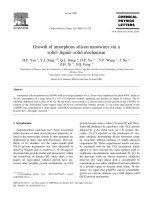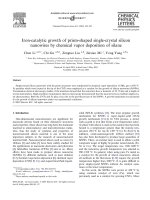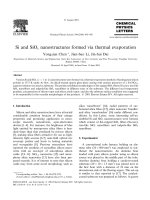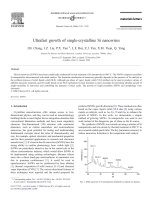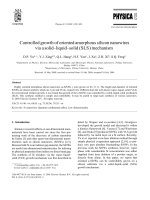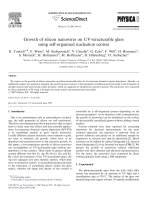- Trang chủ >>
- Khoa Học Tự Nhiên >>
- Vật lý
Temperature-Controlled Growth of Silicon-Based Nanostructures by Thermal Evaporation of SiO Powders
Bạn đang xem bản rút gọn của tài liệu. Xem và tải ngay bản đầy đủ của tài liệu tại đây (758.71 KB, 8 trang )
Temperature-Controlled Growth of Silicon-Based Nanostructures by Thermal Evaporation
of SiO Powders
Z. W. Pan,
†
Z. R. Dai,
†
L. Xu,
‡
S. T. Lee,
‡,
* and Z. L. Wang*
,†,§
School of Materials Science and Engineering, Georgia Institute of Technology,
Atlanta, Georgia 30332-0245, Center of Super-Diamond and AdVanced Film,
Department of Physics and Materials Science, City UniVersity of Hong Kong, Kowloon, Hong Kong
ReceiVed: NoVember 20, 2000; In Final Form: January 17, 2001
Silicon-based nanostructures with different morphologies, sizes, compositions, and microstructures were grown
on Si wafers by thermal evaporation of SiO powders at 1350 °C for 5 h under 300 Torr of a flowing gas
mixture of 5% H
2-
Ar at a flow rate of 50 standard cubic centimeters per minute (sccm). The SiO powders
and Si wafers were placed inside an alumina tube, which was heated by a tube furnace. The local temperature
inside the tube was carefully calibrated by a thermal couple. After evaporation, Si-containing products with
different colors and appearances were formed on the surfaces of the Si wafers over a wide temperature range
of 890-1320 °C and a long distance of ∼85 mm. Basing on the colors and appearances of the products, five
distinct zones, which corresponding to different temperature ranges, were clearly identified from the highest
temperature of 1320 °C to the lowest temperature of 890 °C. They are zone I (1250-1320 °C), zone II
(1230-1250 °C), zone III (1180-1230 °C), zone IV (930-1180 °C), and zone V (890-930 °C). The deposited
products were systematically studied by scanning electron microscopy, transmission electron microscopy,
and X-ray diffraction. The results show that, besides Si nanowires, many other kinds of Si-based nanostructures
such as octopuslike, pinlike, tadpolelike, and chainlike structures were also formed. The temperature distribution
inside the alumina tube was found to play a dominant role on the formation of these structures. It is demonstrated
that a control over the growth temperature can precisely control the morphologies and intrinsic structures of
the silicon-based nanomaterials. This is an important step toward design and control of nanostructures. The
growth mechanisms of these products were briefly discussed.
1. Introduction
Silicon-based nanoscale materials have attracted much at-
tention in recent years for their valuable semiconducting,
mechanical, and optical properties, as well as their potential
applications in mesoscopic research and nanodevices. They are,
for example, considered as candidates for one-dimensional
quantum transistors, composites, and light-emitting diodes.
1
Consequently, a great deal of effort has been made in fabricating
Si-based nanostructures, especially Si nanowires. Several tech-
niques have been developed to produce Si nanowires, including
lithography and etching,
2-4
scanning tunneling microscopy,
5,6
vapor-liquid-solid (VLS) growth,
7-10
laser ablation of metal-
containing Si target
11-14
or metal-free Si/SiO
2
target,
11,15
and
thermal evaporation of Si-SiO
2
mixture
11,16,17
or SiO pow-
ders.
11,18
Among these techniques, the thermal evaporation technique
developed by Lee et al.
11
is of particular interest and has
attracted much attention in recent years due to its low cost and
ease of manufacture. By using SiO powders as the source
material, this technique can be used to easily produce a large
quantity of high-purity (no metal contamination), ultralong (in
millimeters), and uniform-sized (a few nanometers to tens of
nanometers in diameter) Si nanowires. The quality of the Si
nanowires produced by this technique is comparable to those
produced by traditional VLS
7-10
and laser ablation.
11-15
In
thermal evaporation, oxides were found to play a dominant role
in the nucleation and growth of Si nanowires. The growth
mechanism of Si nanowires from thermal evaporation of SiO
powders, however, is not fully understood. Thus, more detailed
and systematic experimental investigations are required.
In this paper, we systematically investigate nanomaterials
produced from thermal evaporation of SiO powders as a function
of the local temperature. Our results show that, besides Si
nanowires, many other kinds of Si-based nanostructures such
as octopuslike, pinlike, tadpolelike, and chainlike structures were
also formed at different temperature zones. Our experiments
show that control of the temperature can also control the
morphology, size, crystallization, and composition of the Si-
based nanostructures.
2. Experimental Method
The apparatus used for thermal evaporation of SiO powders
is schematically shown in Figure 1. An alumina tube was
mounted inside a horizontal tube furnace. A 3-5 g sample of
99.9% pure SiO powder (from Aldrich) was placed in an
alumina crucible and located at the center of the alumina tube.
Several striplike Si wafers (60 mm in length and 10 mm in
width) were placed one by one on a long alumina plate (15 cm
in length and 20 mm in width) to act as the deposition substrates
for the grown materials. SiO is dark brown and SiO
2
is
transparent white. The position of the alumina plate inside the
* Corresponding authors. E-mail: (ZLW),
and (STL).
†
Georgia Institute of Technology.
‡
City University of Hong Kong.
§
School of Materials Science and Engineering and School of Chemistry
and Biochemistry, Georgia Institute of Technology.
2507J. Phys. Chem. B 2001, 105, 2507-2514
10.1021/jp004253q CCC: $20.00 © 2001 American Chemical Society
Published on Web 03/09/2001
alumina tube was exactly measured to correlate the formation
of products with local temperature. Before evaporation, the
alumina tube was evacuated to ∼2 × 10
-3
Torr by a mechanical
rotary pump. Finally, SiO powders was heated at 1350 °C for
5 h under a pressure of 300 Torr; 5% H
2-
Ar gas mixture was
kept flowing through the tube at a flow rate of 50 sccm. During
evaporation, the growth status inside the alumina tube could
be viewed in situ through a quartz window located at the gas
inlet end of the alumina tube.
To measure the temperature distribution along the downstream
direction inside the alumina tube, a thinner alumina tube was
inserted into the larger one along its axis. One end of the thinner
tube was closed and located at the center of the furnace, while
the other end was open and extended outside the furnace. A
thermocouple, which was inserted inside the thinner tube and
could be moved freely along the tube axis, was used to measure
the temperature inside the larger tube. During evaporation, the
temperature at any point between the tube center and the tube’s
downstream end could be measured in situ by using this
temperature measuring device. Thus, the relationship between
local temperature and products could be readily obtained.
After evaporation, the alumina plate, together with the silicon
wafers on it, were carefully removed from the alumina tube
without disturbing the sequence of the deposited products. This
is important for correlating the structures of the local deposited
materials with the temperature. The morphologies of the as-
deposited products were examined by scanning electron mi-
croscopy (SEM) (Philips XL 30 FEG); the microstructures were
investigated by transmission electron microscopy (TEM) (Hi-
tachi HF2000 FE-TEM at 200 kV) and high-resolution TEM
(HRTEM) (JEOL 4000EX at 400 kV); the crystalline state was
analyzed by X-ray diffraction (XRD) (Philips, PW1800 using
Cu KR radiation); the chemical composition was determined
by energy-dispersive X-ray spectroscopy (EDS) attached to the
SEM and Hitachi HF2000 FE-TEM.
3. Experimental Results
Products formed at different temperature zones are distinctly
different in color. Simply by observing the products with the
naked eye, it can be found that, after5hofgrowth at 1350 °C
under 300 Torr with a carrier gas flow rate of 50 sccm, products
with different colors and appearances were formed over a wide
temperature range between 890 and 1320 °C within a distance
of ∼85 mm inside the tube. From the highest temperature of
1320 °C to the lowest temperature of 890 °C, the color of the
products changed from dark gray to bright yellow, yellow mixed
with pink, light yellow, and finally brown. The corresponding
appearance of the deposited products changed from round-tip
short rods to circular hard shell, fine powders, spongelike wires,
and finally long and straight microscale wires, respectively. On
the basis of the colors and appearances described above, five
distinctive temperature zones were identified: zone I (1250-
1320 °C), zone II (1230-1250 °C), zone III (1180-1230 °C),
zone IV (930-1180 °C), and zone V (890-930 °C). Figure 2
schematically depicted the position and the corresponding
temperature of the five zones inside the alumina tube.
3.1. Zone I (1250-1320 °C).
The products formed in zone I were dark gray. The length of
this zone is about 35 mm. Low-magnification SEM image
reveals that a large quantity of round-tip rods with 50-200 µm
diameters and of 0.5-2 mm length were formed in zone I
(Figure 3a). These rods decline to the silicon substrate along
the flowing direction of the carrier gas at almost the same angle,
forming “aligned” structures. High-magnification SEM studies
show that the rods were mainly composed of three kinds of
structures: octopuslike structure (Figure 3b), pinlike structure
(Figure 3c), and nanowires (Figure 3d).
Figure 3b shows a SEM image of the octopuslike structures.
This kind of structure has been observed in samples prepared
by heating SiO
2
on a Ta heater at 1600 °C.
19
Usually, the
octopuslike structure has two to five arms sprout from its
spherical tip. The typical diameters of the tips are in the range
of 1-2 µm. The arm surfaces are smooth, and their diameters
gradually decrease as the distance from the tips increase. TEM
observations (Figure 4a) and EDS analysis show that the tip of
the octopuslike structure is a crystalline Si ball covered with a
thin amorphous silicon oxide layer, while the arm is a crystal
Si wire sheathed with a thick amorphous outer layer of silicon
oxide. The composition of silicon oxide has been determined
as SiO
2-x
, where x ) 0-0.5. HRTEM investigations (Figure
4b) reveal that the Si wire is well-crystallized and has a growth
direction close to 〈112〉, which is different from the 〈111〉 growth
direction of the Si whiskers prepared by the metal-catalyzed
VLS reaction.
7-10
From Figure 3b it can also be clearly seen that, in contrast to
the long arms that sprout from the lower side of the spherical
tip, a few (usually one to four) very short rods extrude from
the upper side of the tip. It seems from the morphology that, if
the growth time were long enough, these short rods would grow
into long arms such as those located at the lower side of the
tip. Therefore, we suggest that these short rods might act as the
nucleation sites of the arms from which the octopuslike structure
was formed.
Figure 3c shows a SEM image of the pinlike structures. Each
“pin” consists of a wire and a ball at its tip. The diameters of
the wires and tips are in the ranges of 0.3-0.8 and 0.5-1.5
µm, respectively, which are smaller than those of the octopuslike
structures. The length of the wires is in the range of 10-50
µm. TEM studies (Figure 4c) show that the pinlike structure
has the same microstructure as the octopuslike structure; namely,
the tip is a Si ball covered with a thin silicon oxide layer and
the wire has a Si core and a thick silicon oxide outer sheath.
In zone I, there also exist many nanowires on the surface of
the round-tip rods, as shown in Figure 3d. These nanowires have
a quite uniform diameter of ∼100 nm and a very long length
of up to several millimeters. TEM studies indicate that the wires
have a core-shell structure (Figure 4d); namely, each wire
consists of a crystalline Si core and an amorphous outer layer
Figure 1. Schematic diagram of the experimental setup.
Figure 2. Schematic diagram of the five distinctive growth zones inside
the alumina tube. The colors and temperature ranges of these zones
are also shown.
2508 J. Phys. Chem. B, Vol. 105, No. 13, 2001 Pan et al.
of silicon oxide. Occasionally, the Si core exhibits bulblike
morphology, but the outer oxide sheath keeps a uniform
diameter (Figure 4e). HRTEM investigations show that the
microstructure of the nanowire is similar to that of the
octopuslike structure shown in Figure 4b. The growth direction
of the nanowires is generally along 〈112〉.
3.2. Zone II (1230-1250 °C).
A bright yellow circular hard shell with outer diameter equal
to that of the alumina tube was formed in the region with
temperatures of 1230-1250 °C. By in situ observing the growth
status through the quartz window, we found that the shell was
initially formed from the inner wall of the alumina tube and
then grew radially toward the tube center to form a circular
shell. If the growth time is long enough, the circular shell will
finally grow into a disklike shell. As a result, the disklike shell
will block up the alumina tube and thus stop the gas flowing
through the tube. The thickness of the shell at the inner wall of
the alumina tube is about 3 mm and then decreases gradually
as the distance from the wall increases. The shell is brittle and
can be easily broken into small pieces.
Low-magnification SEM examination on the surface of the
hard shell reveals the presence of numerous fine pinlike
nanowires (Figure 5a). The diameters of the tips and wires are
in the ranges of 50-200 and 30-100 nm, respectively, which
are much smaller than those of the pinlike structures formed in
zone I. The length of the wires is in the range of 2-10 µm. It
should be noted that no apparent octopuslike structures are
present on the shell surface.
Figure 6a shows the low-magnification TEM image of the
pinlike nanowires. Clearly, each wire has a round tip and a sharp
tail. High-magnification TEM observation reveals that the tips
are not strictly round in shape; instead, most of the tips exhibit
a polyhedral structure and a typically hexagonal cross section
is often observed (Figure 6b). Both TEM examination and EDS
analysis reveal that the tip of the pinlike nanowire is composed
of a crystalline Si ball and a very thin amorphous silicon oxide
layer, while the wire is either amorphous silicon oxide (for the
wires with diameter <50 nm) (Figure 6b) or a crystalline Si
core sheathed with silicon oxide layer (for the wires with
diameter >50 nm) (Figure 6c). It should be noted that, for the
core-shell structure as that shown in Figure 6c, the length of
the Si core is only one-third to one-half of the entire length of
the wire, and the rest of the wire is pure amorphous silicon
oxide.
We also investigated the cross section of the hard shell by
SEM. Surprisingly, the structure of the cross section of the shell
was quite different from the surface structure. Two typical
images taken from the cross section of the hard shell are shown
in Figure 5b,c, where two major forms can be identified. One
form consists of chains of nanoparticles (Figure 5b), while the
Figure 3. SEM images of the nanomaterials formed in zone I. A large quantity of dark gray aligned round-tip rods were formed in this zone (a).
These rods were mainly composed of octopuslike (b), pinlike (c), and wirelike (d) structures.
Figure 4. TEM and HRTEM images of the products formed in zone
I. (a) Dark field TEM image of a octopuslike structure. (b) HRTEM
image of the arm of the octopuslike structure shown in (a). (c) TEM
image of the pinlike structure. TEM images of the Si nanowire with
uniform Si core (d) and bulblike Si core (e).
Growth of Silicon-Based Nanostructures J. Phys. Chem. B, Vol. 105, No. 13, 2001 2509
other form is a short bar with length less than 1 µm (Figure
5c). The morphologies shown in Figure 5b,c might have resulted
from the sintering of the pinlike nanowires that initially formed
and are present on the surface of the shell, due to long time at
high temperature.
3.3. Zone III (1180-1230 °C).
Products with a color of yellow mixed with pink were formed
in zone III. The length of this zone is about 5-10 mm. Usually,
a few pink stripes and a few yellow stripes, perpendicular to
the alumina tube axis, coexist one after the other. Under the
naked eye and optical microscopy, these pink and yellow
products are powderlike, but under SEM, the yellow product
mainly consists of fine pinlike structures (Figure 7a), while the
pink product mainly consists of tadpolelike structures (Figure
7b).
TEM investigations reveal that, as the case shown in Figure
6, the pinlike nanowires formed in zone III in yellow also consist
of a crystalline Si tip and a wire composed of either amorphous
silicon oxide (for the thin wires) or a Si core sheathed with
amorphous silicon oxide layer (for the thick wires).
Figure 8a shows a low-magnification TEM image of the
tadpolelike structures from the pink stripes. It is clearly that
the tadpolelike structure is actually a chain of pins, in which
several pins connect together with the head of one connecting
to the tail of another. In Figure 8b, 20 pins connect one by one
to form a close circle. Higher magnification TEM examinations
show that the particles in the tadpolelike structures are crystalline
Si, while the bars between the particles are either amorphous
silicon oxide (Figure 8c) or a core-shell structure (Figure 8d).
3.4. Zone IV (930-1180 °C).
Large quantities of Si nanowires were formed in zone IV.
The nanowire products covered approximately 30 mm in length
of the Si substrate. The Si nanowires formed in this zone have
been intensively studied previously by Lee et al.
11,14-16,18
Under
optical microscopy, zone IV can be clearly divided into two
regions with almost equal length by the color and morphology
of the wires. In the front region (the corresponding temperature
range is 1050-1180 °C), light yellow nanowires closely attach
Figure 5. SEM images of the products formed in zone II. A yellow
circular hard shell was formed in this zone inside the growth tube.
The surface of the hard shell was composed of numerous pinlike
nanowires (a), while the cross section of the shell was composed of
sintered particle chains (b) and short bars (c).
Figure 6. TEM images of the pinlike nanowires formed in zone
II. The pinlike wires have a round tip and a sharp tail (a). The tip is
crystalline Si, while the wire is either amorphous (b) (for thin
wires) or a Si core sheathed with silicon oxide layer (c) (for thick
wires).
Figure 7. SEM images of the products formed in zone III. The color
of the products formed in this zone is yellow mixed with pink. The
yellow product is composed of very fine pinlike nanowires (a), while
the pink product is composed of tadpolelike nanostructures (b).
2510 J. Phys. Chem. B, Vol. 105, No. 13, 2001 Pan et al.
to the surface of Si substrate to form a nanowire film. In SEM
images, these nanowires appear to have an aligned structure
(Figure 9a), in which the nanowires grow along the same
direction that is parallel to the direction of the flowing carrier
gas. This phenomenon was recently reported by Shi et al.
20
The
thickness of the aligned Si nanowire film is about 10-20 µm.
In the back region (the corresponding temperature range is 930-
1050 °C), a large amount of white yellow Si nanowires tangle
together to form a thick (1-3 mm in thickness) spongelike
domain. SEM observation reveals that although the wires are
curled and tangled, they still exhibit more or less aligned features
(Figure 9b).
TEM and HRTEM studies of the morphologies and structures
show no apparent difference between the Si nanowires formed
in the front region and those formed in the back region. A typical
morphology of the Si nanowires is shown in Figure 10a, where
two kinds of wires can be identified. One kind is Si nanowires
with uniform diameters (20-30 nm) and a smooth surface.
HRTEM examinations show that each wire consists of a
crystalline Si core and an outer layer of silicon oxide (Figure
10b), which is similar in microstructures to the Si nanowires
formed in zone I. However, by comparing Figure 10b with
Figure 4d,e, it can be found that the Si cores of nanowires
formed in zone IV are usually discontinuous, indicating that
the nanowires formed in zone IV have a poorer crystallinity
than the wires formed in zone I. A high density of defects, such
as stacking faults and microtwins, were usually observed in the
crystalline Si core of the wire.
The other kind of wires consists of chains of Si nanoparticles.
HRTEM investigations reveal that the Si nanoparticles in the
chain are Si crystals with different orientations, while the short
bars between the Si nanoparticles are amorphous silicon oxide
(Figure 10c).
3.5. Zone V (890-930 °C).
The color of the products formed in zone V is similar to that
of the source material SiO. From the higher temperature of 930
°C to the lower temperature of 890 °C, wires with color from
light brown to brown and finally to dark brown were formed.
The length of zone V is about 10 mm. In fact, except for color,
no visible difference could be distinguished by the naked eye
between the adjacent light brown wires in zone V and the white
yellow wires in zone IV. However, under SEM, the diameters
of the light brown wires are apparently larger than the white
yellow wires. Parts a, b, and c of Figure 11 show the images
taken from samples with colors of light brown, brown, and dark
brown, respectively. Two main features can be obtained from
these images: (i) the wires formed in zone V are highly aligned
with the growth direction parallel to the flowing direction of
the carrier gas. The diameters of the light brown, brown, and
dark brown wires are in the ranges of 50-200 nm, 0.5-1 µm,
Figure 8. TEM images of the tadpolelike nanostructures (a and b). The particles in the tadpolelike structures are crystalline Si, while the bars
between the particles are either amorphous silicon oxide (c) or a Si core sheathed with amorphous silicon oxide layer (d).
Figure 9. SEM images of the products formed in zone IV. The
products formed in this zone are light yellow (a) and white yellow (b)
Si nanowires, which grow along the flowing direction of the carrier
gas and form quasi-aligned structures.
Growth of Silicon-Based Nanostructures J. Phys. Chem. B, Vol. 105, No. 13, 2001 2511
and 1-5 µm, respectively. All of the wires are straight and long
with lengths up to 3-5 mm. (ii) The surface of the wires is
severely roughened. No crystal growth characteristics can be
found from the morphologies of the wires. EDS analysis reveals
that the wires are composed of SiO.
XRD results taken from the above five zones are summarized
in Figure 12. For the sake of comparison, the XRD spectrum
of SiO powders was also shown in Figure 12. It can be seen
that the samples formed in zones I, II, and III have almost the
same XRD spectra, in which several sharp peaks of cubic β-Si
and a broad peak of silicon oxide coexist. In contrast, the Si
nanowires formed in zone IV exhibit weaker Si peaks and a
stronger silicon oxide peak, which indicates that the Si nanow-
ires formed in zone IV have a lower crystallinity than the
products formed in zones I-III and/or the volume fraction of
Si structure is relatively lower. This is consistent with the TEM
results shown above. The XRD spectrum taken from the wires
formed in zone V reveals that these wires are almost amorphous.
It is apparent in Figure 12 that the XRD spectrum of the wires
formed in zone V is similar to that of the SiO powders, which
indicates that the wires formed in zone V are mainly composed
of SiO. This finding agrees well with the EDS results.
4. Discussion
The results described in Section 3 show that, by thermal
evaporation of SiO powders at 1350 °C for 5 h under 300 Torr
ofa5%H
2-
Ar gas mixture at a flow rate of 50 sccm,
Si-containing products with different morphologies, sizes,
compositions, and microstructures were formed over a wide
temperature range between 890 and 1320 °C and a long distance
of about 85 mm. Our extensive experiments at varied furnace
Figure 10. (a) TEM images of the Si nanowires formed in zone IV,
showing two major morphologies. One is Si core sheathed with an
amorphous silicon oxide outer layer (b); the other is chains of Si
particles with different orientation (c).
Figure 11. SEM images of the products formed in zone V. The
products formed in this zone are light brown (a), brown (b), and dark
brown (c) amorphous SiO wires (from high temperature to low
temperature).
Figure 12. XRD spectra of the products formed in zones I-V, as
well as the source material SiO powders.
2512 J. Phys. Chem. B, Vol. 105, No. 13, 2001 Pan et al.
temperatures (1200-1400 °C) show that the products were
strongly related to the temperature distribution inside the alumina
tube. Within a specific temperature range, products with a
specific color, morphology, and microstructure were formed.
The color character may be accounted for by two factors: one
is the nonuniform distribution of SiO and SiO
2
on the surface,
where the former is dark brown and the latter is white; and the
other is the different morphologies of the products. Both SiO
and SiO
2
are amorphous, and they are very difficult to
distinguish by TEM. Chemical microanalysis may help to
identify the phases, but it becomes inconclusive if the phases
are in nanoscale. Therefore, we believe that the temperature
distribution inside the alumina tube has a dominant influence
on the formation of different products. Now, the question is,
how were these different products formed?
From the information provided by images shown in Figures
3-8, it is clear that the Si-containing octopuslike, pinlike, and
tadpolelike structures formed in zones I-III have a common
feature: crystalline Si balls are consistently present at the wire’s
tips. This feature is consistent with the essential feature of the
VLS growth, in which a metal catalyst particle is always present
at one end of the nanowire (or whisker) to act as the
energetically favored site for absorption of gas-phase reactant.
7-10
Although in our case the tips are Si while in traditional VLS
they are metals (Au, Fe, or Co), we believe that the function of
the Si tips is, to some extent, analogous to that of the metal
catalyst. In fact, the catalytic function of the Si tip for wire
growth has been shown clearly in Figure 3b, in which several
nucleation sites of the wires are extruded from the Si tip.
Since the only source material used in the present study is
SiO, we assume that the nucleation of the Si particle occurs on
the Si substrate by decomposition of SiO described by 2SiO )
Si + SiO
2
. After the Si nucleus is formed, it will grow into a
larger particle by continuously adsorbing SiO from the vapor
phase. To effectively adsorb SiO from the vapor phase, the Si
tips should be in or near their molten states (note the melting
point of particles is lower than that of bulk). Since the SiO vapor
is continuously supplied during the experiment, the molten Si
tips will continuously adsorb SiO; as a result, the Si tips will
become larger and larger. However, the size of the final Si tip
will be limited by the growth temperature; that is, at different
temperature zones, the critical value of the molten Si tip is likely
to be different. This is evident by comparing the sizes of the
tips formed in zones I-III (see Figures 3-8). With consideration
of the phase separation of Si and SiO
2
, it is likely that the newly
formed molecular silica (on the Si surface) tends to diffuse
toward the areas that already have accumulated silica species.
SiO
2
is easily deposited and extruded from the Si tip to form
either an amorphous silicon oxide sheath (for thick wire) or an
amorphous silicon oxide wire (for thin wire). The formed solid
SiO
2
component can retard the lateral growth of the nanowires
to ensure that the wires grow along one direction to form
wirelike nanostructures.
As for the nanowires formed in zone IV, their nucleation and
growth process has been investigated in detail in ref 11 by Lee
et al. Although these Si nanowires do not apparently have Si
tips, their growth can also be attributed to the VLS growth
mechanism. It is of course a non-metal-catalyzed VLS growth
mechanism.
For the wires formed in zone V, both EDS and XRD results
show that these wires are composed of SiO. These results
indicate that no decomposition occurs for SiO vapor at tem-
perature below 930 °C. Such a case also occurs in the
preparation of Si-O powders from a mixture of SiO
2
and Si.
Hass and Sulzberg
21
found that the decomposition of SiO vapor
into Si and SiO
2
should occur above a certain temperature. If
the temperature was below this critical temperature (their
temperature was 800 °C, 130 °C lower than 930 °C in our case),
the SiO vapor directly condensed to form homogeneous
amorphous SiO solid. Basing on the results obtained by Hass
and Sulzberg and our results described in section 3, it can be
concluded that the SiO
2
wires in zone V are formed by directly
depositing SiO
2
vapor along one dimension, which is actually
a vapor-solid (VS) growth process.
An interesting phenomenon in our experiments is the presence
of the aligned structures, e.g., the aligned short rods in zone I,
the aligned Si nanowires in zone IV, and the aligned SiO wires
in zone V. The growth directions of these aligned structures
are all parallel to the flowing direction of the carrier gas,
indicating that the formation of these aligned structures may
be related to the flow of the carrier gas. This point is confirmed
by our extended experiments, which show that, if the gas flow
rate is higher, the aligned feature is much more apparent.
The growth of Si-based nanostructures by evaporation of SiO
is a rather complicated process. Some experimental phenomena
are still not fully understood, including the following: (i) In
zone I, why do the octopuslike and pinlike structure accumulate
together to form the round-tip short rods? (ii) In zone II, why
do the pinlike nanowires sinter together to form a circular hard
shell in the growth tube? (iii) In zone III, why do the pinlike
wires form a nearly perfect tadpolelike structure by accurately
connecting the head of one to the tail of another? (iv) In zone
IV, why are the Si nanoparticles present in the form of long
chains? (v) In zone V, why can SiO be redeposited along one
dimension to form amorphous SiO wires? It is certain that much
experimental and theoretical work is needed to answer these
questions.
5. Conclusion
Silicon-based nanostructures with different colors, morphol-
ogies, and microstructures were formed over a wide temperature
range from 890 to 1320 °C by thermal evaporation of SiO
powders at 1350 °C for 5 h under 300 Torr of a flowing gas
mixture of 5% H
2-
Ar at a flow rate of 50 sccm. Silicon-based
nanostructures with morphologies such as octopuslike, pinlike,
tadpolelike, chainlike, and wirelike were formed in different
temperature ranges. Our experimental data show that the
temperature distribution inside the alumina tube plays a
dominant role in the formation of these structures. It is
demonstrated that control over the growth temperature can
precisely control the morphology and intrinsic structure of the
silicon-based nanomaterials. This is an important step toward
design and control of nanostructures. The Si-based nanostruc-
tures could offer great opportunities for fundamental and applied
research.
Acknowledgment. Thanks to the financial support from US
NSF Grant DMR-9733160 and the Georgia Tech Electron
Microscopy Center for providing the research facility. ZWP was
partially supported by the Research Grants Council of Hong
Kong (Project No. 9040459).
References and Notes
(1) Alivisatos, A. P. Science 1996, 271, 933.
(2) Liu, H. I.; Maluf, N. I.; Pease, R. F. W. J. Vac. Sci. Technol., B
1992, 10, 2846.
(3) Namatsu, H.; Horiguchi, S.; Nagase, M.; Kurihara, K. J. Vac. Sci.
Technol., B 1997, 15, 1688.
(4) Wada, Y.; Kure, T.; Yoshimura, T.; Sudon, Y.; Kobayashi, T.;
Goton, Y.; Kondo, S. J. Vac. Sci. Technol., B 1994, 12, 48.
(5) Ono, T.; Saitoh, H.; Esashi, M. Appl. Phys. Lett. 1997, 70, 1852.
Growth of Silicon-Based Nanostructures J. Phys. Chem. B, Vol. 105, No. 13, 2001 2513
(6) Hasunuma, R.; Komeda, T.; Mukaida, H.; Tokumoto, H. J. Vac.
Sci. Technol., B 1997, 15, 1437.
(7) Wagner, R. S.; Ellis, W. C. Appl. Phys. Lett. 1964, 4, 89.
(8) Givargizov, E. I. J. Cryst. Growth 1975, 32, 20.
(9) Boostma, G. A.; Gassen, H. J. J. Cryst. Growth 1971, 10, 223.
(10) Westwater, J.; Gosain, D. P.; Tomiya, S.; Usui, S.; Ruda, H. J.
Vac. Sci. Technol., B 1997, 15, 554.
(11) Lee, S. T.; Wang, N.; Zhang, Y. F.; Tang, Y. H. Mater. Res. Bull.
1999, 24, 36.
(12) Morales, A. M.; Lieber, C. M. Science 1998, 279, 208.
(13) Zhang, Y. F.; Tang, Y. H.; Wang, N.; Yu, D. P.; Lee, C. S.; Bello,
I.; Lee, S. T. Appl. Phys. Lett. 1998, 72, 1835.
(14) Yu, D. P.; Lee, C. S.; Bello, I.; Sun, X. S.; Tang, Y. H.; Zhou, G.
W.; Bai, Z. G.; Zhang, Z.; Feng, S. Q. Solid State Commun. 1998, 105,
403.
(15) Wang, N.; Zhang, Y. F.; Tang, Y. H.; Lee, C. S.; Lee, S. T. Appl.
Phys. Lett. 1998, 73, 3902.
(16) Wang, N.; Tang, Y. H.; Zhang, Y. F.; Lee, C. S.; Bello, I.; Lee, S.
T. Chem. Phys. Lett. 1999, 299, 237.
(17) Gole, J. L.; Stout, J. D.; Rauch, W. L.; Wang, Z. L. Appl. Phys.
Lett. 2000, 76, 2346.
(18) Zhang, Y. F.; Tang, Y. H.; Lam, C.; Wang, N.; Lee, C. S.; Bello,
I.; Lee, S. T. J. Cryst. Growth 2000, 212, 115.
(19) Zhu, Y. Q.; Hsu, W. K.; Grobert, N.; Terrones, M.; Terrones, H.;
Kroto, H. W.; Walton, D. R. M.; Wei, B. Q. Chem. Phys. Lett. 2000, 322,
312.
(20) Shi, W. S.; Peng, H. Y.; Zhang, Y. F.; Wang, N.; Shang, N. G.;
Pan, Z. W.; Lee, C. S.; Lee, S. T. AdV. Mater. 2000, 12, 1343.
(21) Hass, G.; Sulzberg, C. D. J. Opt. Soc. Am. 1954, 44, 181.
2514 J. Phys. Chem. B, Vol. 105, No. 13, 2001 Pan et al.

